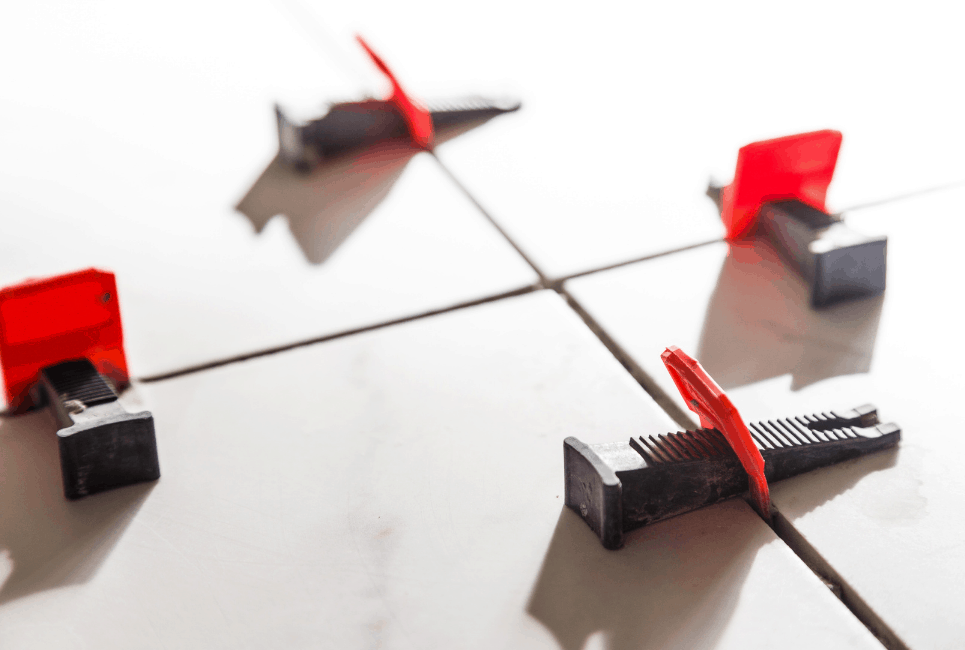- LL Flooring Review: Should You Buy From There? - June 25, 2022
- Grizzly G0771Z Review: Do We Recommend? - June 25, 2022
- Micrometer vs Caliper Compared: Which Measurement Tool Should You Buy? - June 25, 2022
Leveling is a major part of kitchen floor renovation projects, as failing to create a flat surface can pose a tripping hazard. Learning how to find the best tile leveling system can help you overcome many of the obstacles you may encounter while working on bathroom improvement ideas.
However, you shouldn’t think that a tile leveling system eliminates the need to create a flat, smooth, and even substrate flooring surface before you start installing tiles. These systems are merely tools that help you reduce lippage to the minimum and align the grout lines perfectly.
So, in this guide, we’re going to show you how to find the best tile leveling system that will make it easier to complete a kitchen improvement or any other project that involves laying tiles.
Top 5 Tile Leveling Systems – Overview
| Model | Number of pieces | Tile position | Price range |
| Spin Doctor Lippage Control System | 100 caps, 250 base plates | Horizontal/vertical | $$ |
| TOPWAY Tile Leveling System | 100 pieces | Horizontal/vertical | $$ |
| Peygran Tile Leveling System | 400 clips, 200 wedges | Horizontal/vertical | $$$ |
| T-Lock Tile Leveling System | 300 spacers, 100 wedges | Horizontal/vertical | $$$ |
| OGORI Tile Leveling System | 300 spacers, 100 wedges | Horizontal/vertical | $$ |
What is a tile leveling system?
In order to understand what a tile leveling system is, you need to be familiar with the term lippage. The height difference between two neighboring tiles is called lippage, and ideally, all tiles you install should be at the same level.
In most cases, this is easier said than done, as the surface on which you’re installing tiles isn’t always perfectly flat. Consequently, peaks and valleys can occur, if tiles are installed onto an uneven surface, which makes the final result less functional.
A tile leveling system is composed of elements that ensure all tiles are at the same height and eliminate shrinkage that occurs once the adhesive dries. Also, they help maintain the equal amount of space between tiles that is needed to create perfect grout line junctions.
It is worth noting that these systems can be utilized on both horizontal and vertical surfaces with the same level of efficiency. Go through our guide to the best tile flooring options to find out more about different types of tiles.
The applications of tile leveling systems
A tile leveling system can be used during all tile installation projects, regardless of the size of tiles you’re installing. However, these systems don’t solve the issue of an uneven surface, and you shouldn’t start laying out the tiles or applying adhesive until you’ve made sure that the floor or wall substrate is flat.
Eliminating lippage doesn’t necessarily mean that tiles are going to be flat and you shouldn’t use them to manipulate tiles so that they can follow the peaks and ridges of the substrate.

Consequently, you should view a tile leveling system as a tool that enables you to fine-tune the height, or spacing between two adjacent tiles, rather than a way to deal with uneven substrate surfaces.
Following the standard tile installation procedure that requires you to arrange tiles across the surface and then apply adhesive to one tile at a time is the best practice even if you’re using a tile leveling system.
The most common types of tile leveling systems
All tile leveling systems serve the same purpose, but they do so utilizing two different methods. So, the system’s installation process and its accuracy depend on the components it contains.
Clip-and-wedge
This is by far the most common type of tile leveling system that is based on a crosshead or a clip that is positioned between two tiles. The clip features a slot for a wedge, so once you insert a wedge into the slot, you can utilize pliers to set the amount of pressure the system is going to apply to a tile.
A clip-and-wedge system is designed to align tiles of particular widths, which is the reason why you can’t use it to eliminate lippage on all types of tiles. Most clip-and-wedge systems enable you to level tiles that are between 1/8-inch and ½-inch thick.
Also, you can utilize clips as spacers to create sufficient separation between adjacent tiles. Go through our guide to the best-wet tile saws for more information about tools you can use to cut tiles.
Rotating caps
A tile leveling system that is based on rotating caps features a base plate and a rotating cap that enables you to set the level of pressure you want to apply to a tile. You can rotate the cap with your hand or use a wrench that comes with the system you selected.
A rotating cap tile leveling system can be challenging for inexperienced tilers, as they require more attention to detail than clip-and-wedge systems.
How to install and remove tile leveling systems
This installation process of a tile leveling system depends on the system you choose. In case you’re working with a clip-and-wedge system you’ll have to place a clip between adjacent tiles and then insert a wedge into the slot.
Hence, it won’t take you a lot of time to install a clip-and-wedge system over the entire surface you want to cover with tiles. You should keep in mind that you won’t have too much control over the level of accuracy or the amount of pressure you’re applying to a tile.
Removing a clip-and-wedge system is a straightforward process, as the wedges are designed to break under the grout line, once the adhesive sets. On the other hand, a system that features rotating caps has to be removed before mortar or thinnest become solid in order to avoid trapping them.
Also, this system enables you to control the amount of pressure you’re applying to tiles, and in doing so they increase your level of accuracy.
Matching the tile sizes
A tile leveling system you choose has to match the size of the tiles you’re installing. Besides, when working with clip-and-wedge systems, the maximum width of grout lines you can create depends on the thickness of a clip.
Most models feature 1/8-inch clips, which means that you have to install spacers separately if you want to make wider grout lines. The size of the slot into which a wedge is inserted determines the maximum width of tiles you can work with.
In most cases, clip-and-wedge leveling systems allow you to work with tiles that are between 1/8-inch and ½-inch thick.
The size of the base plate in all rotating cap systems is set to 1/8-inch, which is the reason why they shouldn’t be used as spacers. However, these systems enable you to work with tiles that are up to 5/8-inch thick and they provide you with more versatility than clip-and-wedge leveling systems.
Check out our guide to different types of flooring you can use on your home renovation projects.
The advantages of tile leveling systems
Simple installation process
It doesn’t take a lot of time or effort to install a tile leveling system, as both available system types require you to simply place a clip or a base plate underneath a tile and then use a wedge or a cap to lock them in position.
Lippage elimination
All tile leveling systems help their users to keep adjacent tiles at the same height and either reduce or eliminate lippage across the entire surface of a floor or a wall.
Tile leveling systems are reusable
Most components of tile leveling systems can be used on more than one occasion, which means that you can use the same system to install tiles on several surfaces. However, you should keep in mind that the clips in clip-and-wedge systems are not reusable.
The disadvantages of tile leveling systems

Tile leveling systems don’t fit all tile thicknesses
These systems are not universal, so you will have to get a tile leveling system that supports the thickness of the tiles you’re installing. Also, it is advisable to purchase tile spacers separately and avoid using a tile leveling system to determine the spacing between tiles.
Factors worth considering while choosing a tile leveling systems
Choosing a tile leveling system shouldn’t be a difficult process, especially if you already know the thickness of the tiles you want to install. However, this doesn’t mean that you should opt for the first tile leveling system you lay your eyes on.
Going through the system’s list of specifications will enable you to know if it is suitable for the context in which you want to use it. Let’s take a closer look at the factors that can help you narrow down your choices.
Tile leveling system type
There are just two types of tile leveling systems. Clip-and-wedge systems are better suited for novice tilers that want to cover large surfaces with tiles because it takes just a few moments to install them.
The installation and removal of rotating cap systems require more skill, which makes these systems a better choice for professional tilers.
The number of pieces
Each tile leveling system comes with a different number of pieces. The number of pieces a system contains determines the size of the area you can cover. Also, some kits include wrenches and other accessories that facilitate the installation process.
Tile compatibility
Some tile leveling systems don’t work well with thick and large tiles because they can’t apply enough pressure to eliminate lippage. That’s why you need to check the features of the system you’d like to get to find out if you can use it with tiles you’re installing.
Ease of use
Getting a rotating cap tile leveling system will increase the amount of time you will need to complete a project because installing and removing rotating caps can be a slow and lengthy process. You should opt for a clip-and-wedge system if you value time over accuracy.
Cost and durability
Tile leveling systems are affordable since even the most expensive models cost a little over a hundred dollars. The exact price of the system depends on the number of pieces it contains, and the cheapest options usually contain 50 pieces or less.
Even the least expensive tile leveling systems are reusable, but how frequently you’ll have to replace them depends on their durability.
Top 5 tile leveling systems
Spin Doctor Lippage Control System – The Best Rotating Cap Tile Leveling System

Professional and DIY tilers that need a high level of accuracy during the tile installation process can benefit from getting the Spin Doctor Lippage Control System. Besides eliminating lippage, this system also helps you regulate the spacing between tiles with its 1/16-inch and 1/8-inch spacers.
The Spin Doctor’s tile leveling system comes with a hundred reusable caps and 250 1/8-inch base plates that grant you complete control over the amount of pressure you’re applying to a tile. As a result, this system can be used with both small and large tiles with the same level of efficiency.
Attaining a flat and level tile floor or wall has never been so simple. Other systems require the use of unique tools or pliers, but the Spin Doctor tile leveling system can be installed by hand. The patented free-spinning leveling caps can be spun down the threaded post with just one hand.
Pros
- Tightening the cap is easy
- This leveling system contains a large number of pieces
- The Spin Doctor system can create separation between tiles
- Moderately priced
Cons
- Learning how to use this tile leveling system may take a while
- Base plates are not reusable
TOPWAY Tile Leveling System – The Most Accurate Tile Leveling System

Eliminating lippage isn’t going to be a difficult task if you opt for the TOPWAY Tile Leveling System that allows you to regulate the pressure tiles are taking. Pieces in this kit are made of durable semi-crystalline plastic and they feature a stainless steel tip, which means that you can use this system for a long time.
Tightening pieces doesn’t require you to use wrenches or other tools as their design enables you to fasten them with your hands. Pieces from this tile leveling system are compatible with all tiles thinner than 0.8-inches.
Constructed using semi-crystalline thermoplastic with a stainless steel tip that is 1.4mm thick, the Topway tile leveling system is highly impacted resistant and is sure to see you through many uses.
Pros
- Built from high-quality materials
- Controlling the pressure level is easy
- All pieces in the kit are reusable
- Suitable for a broad range of tiles
Cons
- The kit contains just 50 pieces
- The installation process can be difficult
Peygran Tile Leveling System – The Best Tile Leveling System for Large Tiles

In case you’re searching for a tile leveling system that can be used to even out a surface, then the Peygran Tile Leveling System might be the right choice for you. Besides ensuring that tiles are correctly positioned, the system enables you to achieve uniformity over large surfaces.
The kit contains 400 clips and spacers, as well as 200 wedges, which is more than enough to cover the surface of an entire wall or floor. What’s more, the Peygran Tile Leveling System comes with a wrench you can utilize to adjust the amount of pressure this clip-and-wedge system is applying to the tiles.
With the widest variety of clip sizes and advanced pliers – the Peygran leveling system reputation is certainly deserved.
Pros
- The quick and easy removal process
- Great for novice tilers
- Features a large number of clips and wedges
- This tile leveling system comes with a carrying case
Cons
- More expensive than the alternatives
- Durability can be an issue
T-Lock Perfect Level Master Anti-Lippage Tile Leveling System – The Best Clip-and-Wedge Tile Leveling System

Only a handful of models on the market are so highly praised by professional tilers as the T-Lock Perfect Level Master Anti-Lippage Tile Leveling System.
Each of the 300 clips and 100 wedges in this system is easy to install so that you don’t have to waste time determining the right amount of pressure you should apply to each tile.
This T-Lock kit ensures that all tiles are at the same level and perfectly aligned, and you can choose between models that come with 1/8-inch, 1/16-inch, and 1/32-inch clips depending on the thickness of tiles you’re working with.
The Perfect Level Master is a high-quality wall & floor tile leveling system if you are wanting the utmost best for your job without any breakages.
Pros
- The kit contains enough clips to cover a 65 sq ft area
- All wedges in the kit are reusable
- Prevents tiles from warping
- Simple installation and removal process
Cons
- High price tag
- The kit features only a 1/8-inch spacer
OGORI Tile Leveling System – The Most Affordable Tile Leveling System

The competitive price and straightforward installation process make the OGORI Tile Leveling System an attractive option for most DIY tilers.
You can fasten wedges with 5-gear tile leveling pliers that feature a non-slip handle that is included in the kit. You can use this leveling system with all tiles that are thinner than ½-inch.
Also, this kit enables you to create separation between tiles that is up to 1/8-inches wide, but you should keep in mind that the accuracy level of this tile leveling system is far from perfect.
Pros
- Compatible with a broad range of tiles
- Speeds up the tile leveling process
- Easy installation process
- The kit contains a hundred reusable wedges
Cons
- Low accuracy level
- Made from flimsy materials
Frequently asked questions about tile leveling systems
Answer: Although a tile leveling system can reduce lippage significantly, it doesn’t eliminate it. Hence, in some situations, a lippage of 1/16-inch is permissible.
Answer: Clips don’t always break perfectly and if that happens you’ll have to use a sharp tool to remove the part of the clip and keep the grout line clear.
Answer: The area you can cover with one tile leveling system depends on the number of pieces included in the kit and the dimensions of the tiles. In most cases, you’ll need around a hundred pieces to level a 25sqft area.
Answer: The accuracy level of a tile leveling system depends on the amount of pressure it can apply to tiles, hence the systems that allow the user to set the preferred amount of pressure tend to be more accurate.
Our Verdict: How to Know Which Tile Leveling System Produces the Best Results?
Lippage can become a huge problem, especially if you’re working with large tiles. Tile leveling systems offer a simple solution to this issue by keeping adjacent tiles at the same level until the adhesive hardens.
Installation methods, pressure adjustments, or the removal process depend on the tile leveling system type so you can choose either accuracy over speed or the other way around.
We recommend the TOPWAY Tile Leveling System if you want to keep the lippage next to zero and you don’t mind the slow installation process. The T-Lock Perfect Level Master Anti-Lippage Tile Leveling System may be a more suitable option for you if you want to level a large tile area quickly.
Which of the best tile leveling systems are you going to choose? Let us know in the comments or continue reading our guide to some of the best mosaic tile backsplash kitchen ideas.
Constructed using semi-crystalline thermoplastic with a stainless steel tip that is 1.4mm thick, the Topway tile leveling system is highly impacted resistant and is sure to see you through many uses.








